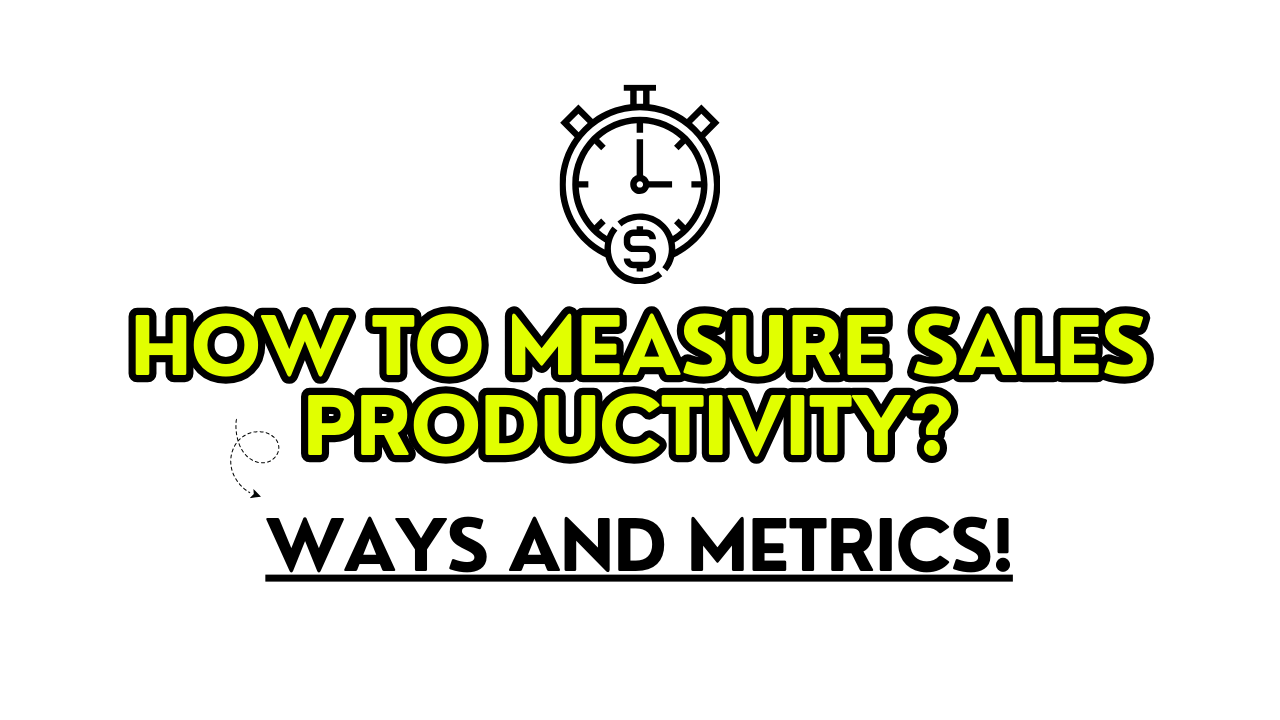Remember the last time your sales team celebrated hitting their monthly targets?
The high-fives, the congratulatory emails, maybe even a team dinner.
It felt like a clear win. And it was!
But…
When the confetti settled and everyone went back to chase the next goals and quotas, have you thought:
Was this really a sign of the team’s health, or just a lucky shot? Is the team actually that good? Could we do more? Can we be more productive?
The answer to all of these questions can be found in sales productivity and in this article we get real about it.
Forget the sugar-coated metrics and the once-in-a-blue-moon wins.
We’re talking about the everyday grind, the numbers that show whether you’re building a solid foundation or just skating by on the occasional victory.
Let’s face it, in sales, it’s easy to get caught up in the moment.
A good month can make you feel invincible, a bad one can send you spiraling.
But what’s the true measure of your team’s effectiveness?
That’s what we’re diving into.
Into the metrics that matter day in and day out, and ones that tell you if you’re really moving the needle or just running in place.
Look, this isn’t just another sales guide.
It’s a reality check.
A way to bring your feet back to the ground and see your team’s performance for what it really is. We’re stripping away the fluff and getting down to the brass tacks of sales productivity.
It’s time to get personal with your numbers, to really understand what drives your success, and to identify what’s holding you back in 2024.
So, are you ready to jump into this no-nonsense, straight-talking guide to measuring sales productivity?
Just kidding, we know you are. Let’s get started.
Summary
This blog is your straightforward guide to really understanding your sales team’s performance.
We’re not just skimming the surface with easy wins and gut feelings.
Here, we dig deep.
You’ll learn about the key metrics that define sales productivity – the real indicators that separate a thriving team from one that’s just scraping by.
Expect to confront some hard truths and uncover potential blind spots.
This isn’t about feel-good moments, no, it’s about gaining a clear, unvarnished view of your team’s performance.
By the end of this blog guide, you’ll have a solid grasp on what sales productivity really looks like and how to measure it accurately.
No unnecessary stuff – just what you need to push your sales team up in 2024.
Let’s get into it.
What is Sales Productivity?
So, what exactly is sales productivity?
Let’s break it down in simple terms.
Simply put, Sales Productivity is how effectively your sales team converts time and effort into sales results.
Think of it like a high-performance engine – it’s not just about how much power it has, but how efficiently and consistently that power is delivered.
Here’s the deal: Sales productivity is looking at what your team puts in versus what they get out.
This is more than counting the sales or deals they close.
Here we focus on figuring out how smartly they’re using their resources – time, leads, energy.
Are they hitting the mark with every effort, or just throwing everything at the wall and seeing what sticks?
This concept is crucial because it goes beyond just looking at the end results. It peels back the layers to show you how those results were achieved.
Was it through strategic planning and skilled execution, or just a volume of calls and emails?
Sales productivity gives you a clear picture of how your team operates, allowing you to identify strengths to build upon and weaknesses to address.
In a nutshell, talking about sales productivity is really talking about how effective and efficient your team is. How good are they at turning their hard work into real, solid sales? That’s what gives you the true picture of how your team is performing.
Why is it so important to track Sales Productivity?
Alright, so why should you even bother tracking sales productivity in 2024?
First off, it’s all about growth.
You want your business to grow, right?
Well, tracking sales productivity is how you figure out if you’re on the right path.
It shows you if your company sales team is doing the right things to not just hit targets (KPIs) and goals but smash them.
It’s like having a fitness tracker for your sales team – it keeps you on track and pushing for better results.
Then there’s efficiency.
Let’s be real, resources aren’t unlimited.
You’ve got budgets, time constraints, all that stuff.
Tracking sales productivity helps you see if you’re using what you’ve got in the smartest way possible. Are you getting the most bang for your buck, or just burning through cash and hours with little to show for it?
And don’t forget about spotting problems early.
When you’re keeping an eye on productivity, you can catch issues before they blow up.
Maybe a strategy isn’t working, maybe there’s a weak spot in your sales process, or maybe some sales reps aren’t doing what needs to be done?
Knowing about these early means you can fix them fast, rather than letting them fester and cause bigger problems down the line.
Plus, tracking sales productivity keeps everyone on their toes.
It’s easy for teams to get comfortable, especially after a few good runs.
Regular tracking?
That’s your way of keeping the teams momentum going, making sure everyone’s pushing to be better, not just doing enough to get by.
Most importantly, it’s about making smart decisions.
When you track productivity, you get the data to back up your choices.
You’re not just going with your gut – you’re making decisions based on what the numbers tell you.
That’s how you steer your team towards consistent, sustainable success.
In short, tracking sales productivity isn’t just a nice-to-have.
It’s essential.
It drives growth, ensures you’re using resources wisely, helps you catch and fix issues early, and keeps your team motivated.
That’s why it’s a big deal.
What are Sales Productivity Metrics?
So, what are sales productivity metrics exactly?
Well, these metrics are specific numbers that tell you how well your team is doing.
Basically you can look at them as the scoreboard for your sales team.
And no, it’s not just about how many sales they make, but how they make those sales. Let us explain.
Imagine you’re a coach of a sports team.
Now, you don’t just want to know the final score.
You want to know how many shots were taken, how many were on target, how the team worked together, right?
Sales productivity metrics are like that.
They break down the sales process into parts you can measure and improve.
Some of these metrics look at the outcomes, like total revenue or the number of deals closed.
But it’s not all about the end result.
Other metrics focus on the process.
How long does it take to close a deal?
How many calls does it take to get a meeting?
These numbers help you see if your team is working efficiently or just spinning their wheels.
Essentially, sales productivity metrics give you the full picture.
They show you where your team is strong and where they need to up their game.
Also, tthey allow you can spot trends, make smart changes, and keep your team moving forward.
In a nutshell, sales productivity metrics are your go-to numbers for understanding and improving how your sales team operates.
They’re the real deal in measuring performance, efficiency, and effectiveness in your sales process.
Enough talking, let’s take a look at them.
What key metrics should you consider for Sales Productivity and why?
Now that we’ve got a grip on what sales productivity metrics are, let’s zero in on the key ones you should be keeping an eye on.
Why?
Because not all metrics are created equal. Some give you a clear insight into your team’s performance, while others might not tell you much.
Think of it like this: if you’re trying to improve your health, you don’t just weigh yourself. You check your diet, your exercise routine, your sleep patterns. It’s the same with sales productivity. You need to look at a mix of metrics to get the true health of your sales efforts.
So, get ready. We’re about to dive into the metrics that matter most in sales productivity, and why they should be on your radar. This isn’t about drowning in data – it’s about focusing on what counts.
Let’s get down to business.
Metric #1 Revenue

Let’s kick things off with Revenue. It’s the big kahuna of sales metrics and the headline number that everyone looks at first.
Why?
It’s simple: at the end of the day, it’s all about the money and evenue tells you straight up how much cash your team’s bringing in.
It’s the ultimate scorecard of your sales team’s efforts.
High revenue?
That’s a sign your team is doing something right, they close more than enough customers your company needs to stay afloat.
But here’s the kicker: it’s not just about the total amount. You’ve got to look at how this number changes over time.
Is it going up?
Steady?
Or taking a nosedive?
Consistency is key with revenue.
A big spike is great, but what you really want is steady growth.
That means your team isn’t just riding on one-off wins.
They’re building and maintaining customer relationships, finding new opportunities, and closing deals on the regular.
So, when you’re tracking revenue, don’t just celebrate the big numbers.
You’ve got to dig deeper to understand the ‘how’ and ‘why’ behind those numbers.
That’s where the real insights lie.
Metric #2 Sales Conversion Rate
Next up, let’s talk about Sales Conversion Rate.
This one’s a game-changer.
While revenue tells you about the ‘what,’ the conversion rate tells you about the ‘how effective.’
This measures how many of the leads or prospects your team talks to actually end up buying and becoming customers.
Think of it like fishing.
You can throw a net into the ocean, but what really matters is how many fish you catch, right?
That’s your conversion rate – the percentage of your leads that turn into actual sales. It’s a clear indicator of how well your sales team can turn potential into profit (potential leads into customers).
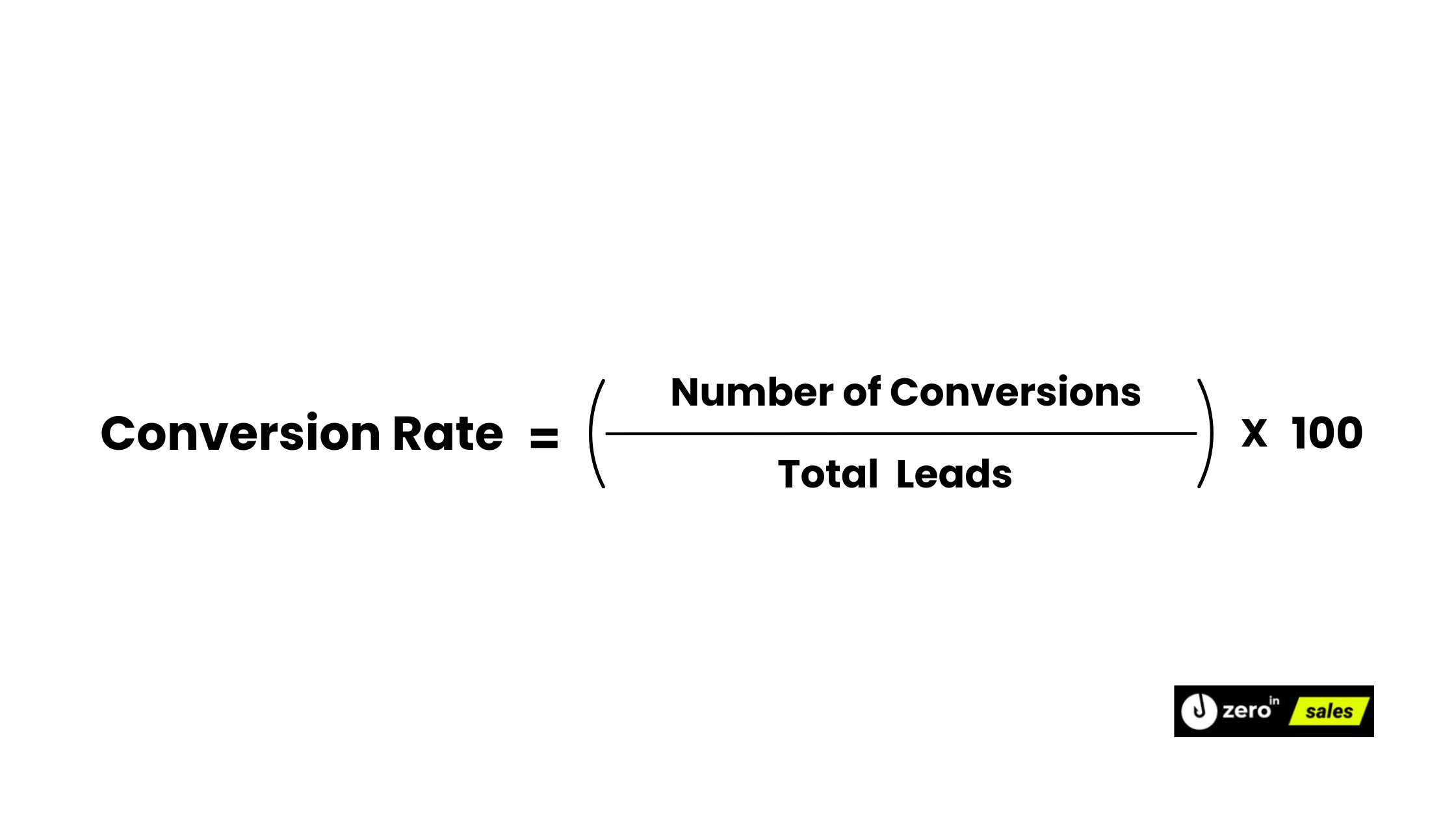
A high conversion rate?
That’s a thumbs-up.
It means your team isn’t just casting wide – they’re precise.
They know their customers, understand customer needs, and can pitch your product or service just right.
On the other hand, a low conversion rate could be a warning sign. Maybe the sales pitch needs tweaking, or perhaps you’re not reaching out to the right prospects.
So, keep a close eye on your sales conversion rate. It’s not just a number. It’s a mirror reflecting your sales strategy’s effectiveness. High, steady rates point to a well-oiled sales machine. Fluctuating or low rates? That’s your cue to dive in and see what needs fixing or improving.
Metric #3 Average Deal Size
Moving on to Average Deal Size. This metric is exactly what it sounds like – it’s the average amount of money you make from each sale.
Why does this matter?
Well, it’s like looking at the quality of your sales, not just the quantity.
Let’s put it this way: If you’re selling a bunch of small deals, it’s like catching a bucketful of small fish. Sure, it adds up, but what if you could catch fewer, bigger fish?
Bigger deals mean more revenue per sale, and that’s often more efficient than chasing a lot of small ones.
A bigger average deal size can mean your team is hitting those valuable sales, the ones that really boost your bottom line.
But here’s the catch – you don’t want to go all-in on just the big fish and ignore the smaller ones.
It’s about finding that sweet spot, the right balance between big and small deals.
Tracking your average deal size helps you understand your sales strategy.
Are you targeting the right customers? (Worthwhile read: Prospect Segmentation: Extensive Guide for Sales in 2024!) Are your pricing strategies working?
A rising average deal size could mean you’re moving upmarket or adding more value to your offerings. On the flip side, if it’s dropping, you might need to look at your customer mix or how you’re packaging your products.
In short, average deal size isn’t just a number – it’s a window into the kind of sales your team is making and a pointer towards where you might need to adjust your prospecting strategies.
Metric #4 Selling time
Now, let’s talk about Selling Time.
This one is all about efficiency.
Selling time is the amount of time your sales team actually spends selling.
Sounds straightforward, but there’s more to it than you might think.
Imagine this: If your sales team spends most of their day on admin tasks, customer service, or just stuck in meetings, that’s less time they’re out there selling to potential customers. It’s like a runner spending more time tying their shoes than running the race.
What you want is for your team to spend the majority of their time doing what they do best – selling.
This metric helps you figure out if they’re doing that. A high selling time means they’re on the phone, meeting customers, doing demos – you know, the stuff that actually leads to winning customers.
If you find out that the selling time is lower than you’d like, it’s a wake-up call.
Maybe it’s time to streamline those admin tasks, cut down on unnecessary meetings, prioritize sales leads better or provide better tools to make the selling process smoother and get more wins.
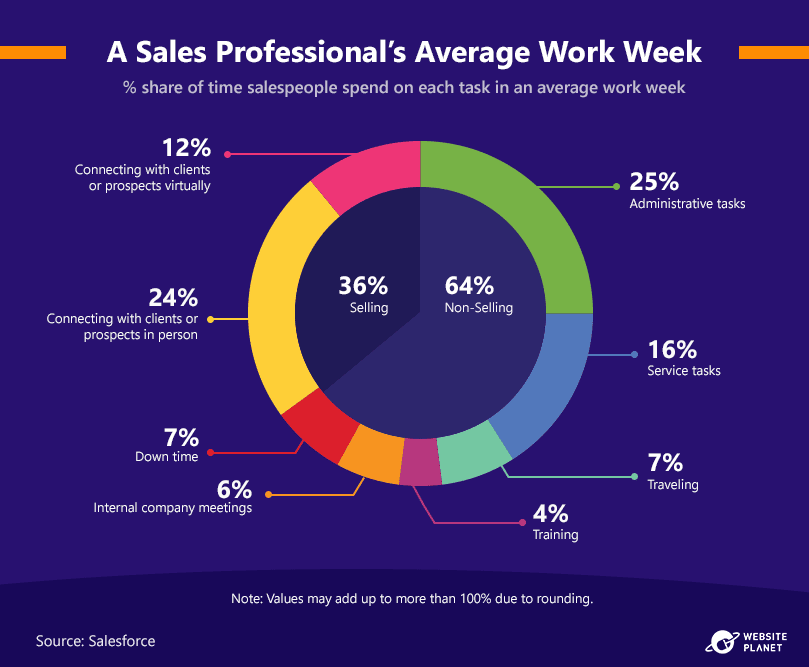
In essence, selling time is your reality check. It shows you whether your team is spending their time wisely or getting bogged down in things that don’t contribute directly to making sales. Keep an eye on this, and you’ll keep your team focused on what really counts.
Metric #5 Lead Response Time
Alright, next up is Lead Response Time.
This one’s crucial and often overlooked. It’s all about how quickly your sales team responds to a lead. In the sales game, speed can make or break a deal.
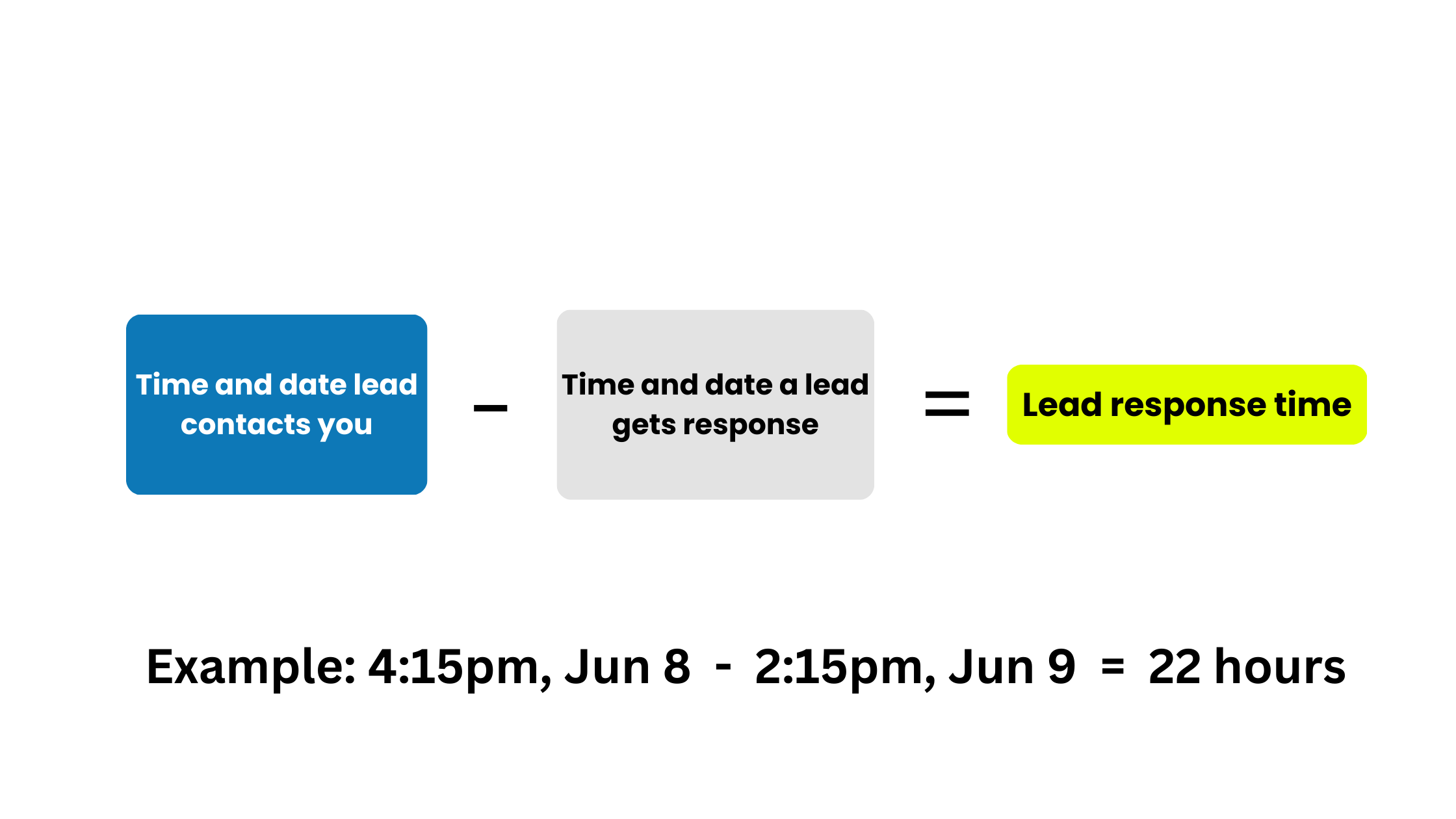
Think about it.
When someone shows interest in your product, they’re not going to wait around forever.
The longer you take to get back to them, the colder that lead gets.
It’s like fishing – if you don’t reel in fast, the fish might just swim away.
A quick response time shows you’re on the ball. It tells the lead they’re important to you and that you’re eager to help. This not only increases the chances of converting the lead but also sets the tone for your relationship with them.
Now, if your team’s response time is lagging, it’s a red flag. It could mean you need better processes, more staff, or just a better system to track and respond to leads. Maybe it’s time to look into automation tools or a better CRM system.
In short, Lead Response Time isn’t just about being fast, it’s about being ready and responsive.
Keep it short, and you keep your leads warm and your sales pipeline healthier.
Metric #6 Handling time
Handling time takes us into the nuts and bolts of your sales process.
This metric measures how long it takes for a rep to handle an interaction, like time-on-call or the amount of time spent sending an email and the subsequent follow-up activities.
It’s a direct look at how efficient your reps are and their capacity to manage interactions.
Imagine this: You’ve got a rep spending an hour on a call that could be wrapped up in 15 minutes. That’s efficiency slipping through the cracks.
On the flip side, a rep spending 5 minutes on a call might be speedy, but are they really building a relationship, understanding customer needs, and closing deals effectively? It’s a fine balance.
Now, cutting down handling time might seem like a straightforward way to boost productivity.
The less time spent per interaction, the more interactions, right?
In theory, yes. But here’s the critical part – it should never come at the cost of quality.
Rushing through customer interactions to tick more boxes can backfire, damaging relationships and trust.
To calculate handling time for a sales call, you’ll add up all the talk time plus the time spent on follow-up actions, then divide it by the total number of calls made.
This gives you an average that can help you gauge the efficiency of your team.
Remember, it’s not just about making your team faster.
It’s about making them smarter in how they use their time.
The goal is to find that sweet spot where efficiency meets effectiveness, leading to more conversions without sacrificing the quality of your customer interactions.
Metric #7 Time-to-productivity
Time-to-productivity is a metric that sheds light on the efficiency of your onboarding and training processes.
It measures how quickly new reps get up to speed, adopt your tools and methodologies, and start contributing to sales.
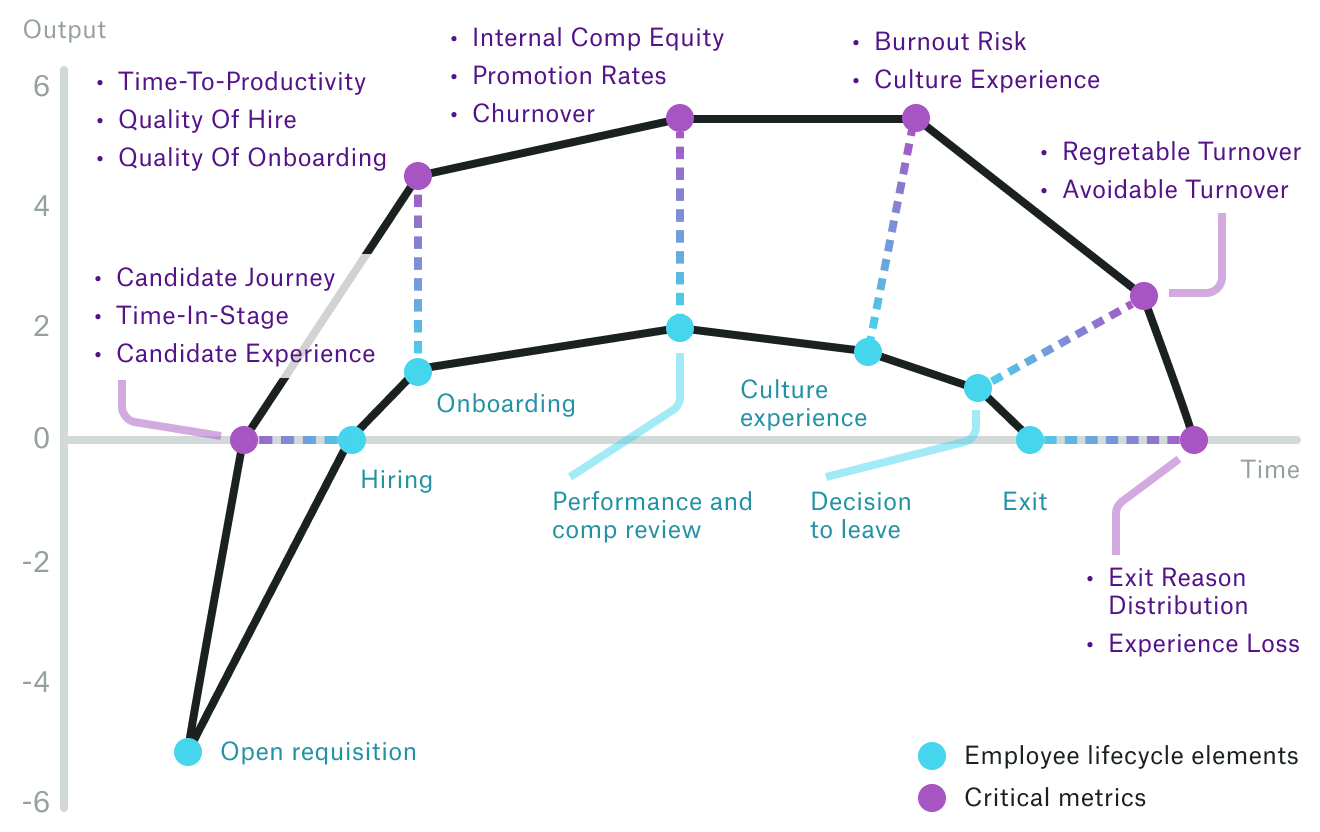
Essentially, it’s a timeline that shows how fast a new member of your team ramps up to hit their sales quotas.
Think about it as the break-in period for a new car.
You want to know how long it takes before it’s running at optimal performance.
For your sales team, this metric is crucial.
It doesn’t just reflect on the new hire. it’s a direct indicator of how effective your training methods are and how user-friendly your tech stack is.
A shorter time-to-productivity means your new reps are getting the hang of things quickly, which in turn means they’re starting to generate revenue sooner.
This is good news all around. It shows your onboarding process is on point, your training is effective, and your tools are intuitive.
On the flip side, if it’s taking too long for new reps to become productive, it might be time to revisit your training approach or simplify your sales tools.
Maybe the process is too complex, or the tools aren’t as straightforward as they could be.
In the end, tracking time-to-productivity isn’t just about pushing new hires to perform fast.
It’s about fine-tuning your entire onboarding and training system to create a smoother, more efficient path to productivity for everyone who joins your team.
Metric #8 Opportunity Losses
Opportunity Losses are the “what could have been” in your sales process.
This metric highlights the deals that slipped through your fingers and the revenue that could have been on your books but isn’t.
It’s an essential measure, giving you insight into missed opportunities and potential areas of improvement.
Picture this: You’re fishing with a net that has a few holes. Sure, you’re catching some fish, but some are escaping through those gaps. That’s what opportunity losses represent – those missed catches that could have significantly boosted your haul.
Tracking opportunity losses can be a bit of an eye-opener.
It’s not just about the deals that didn’t close. It’s about understanding why they didn’t close.
- Was it the pricing?
- The product features?
- The timing?
Each lost opportunity has a story, and understanding these stories is key to preventing future losses.
Opportunity losses also push you to refine your sales strategies.
Maybe you need to relook at your lead qualification process, or perhaps your follow-up strategy needs tweaking.
It’s all about turning these losses into learning experiences that strengthen your sales approach.
Metric #9 Quota Attainment
Quota Attainment is like the report card for your sales team.
It measures how well your reps are meeting, or better yet, exceeding their sales targets.
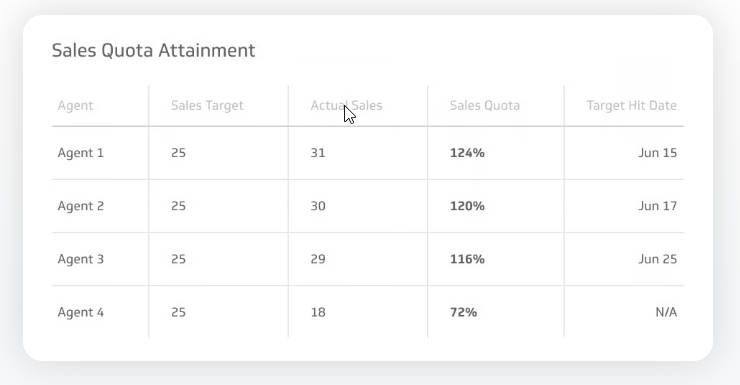
This metric is a straightforward indicator of individual and team performance.
It tells you who’s knocking it out of the park and who might need a bit more coaching.
When you look at quota attainment, you’re seeing directly how effective each member of your team is in achieving what’s expected of them.
But it’s not just about setting targets and watching sales reps chase them.
Quota attainment also reflects on your sales strategy and goal-setting process.
Are the quotas realistic?
Are they challenging enough?
If most of your company sales team is consistently missing their quotas, it could mean the targets are too steep or the market conditions have changed. If everyone’s exceeding them by a mile, maybe it’s time to raise the bar.
Tracking quota attainment helps you align your team’s efforts with your business goals. Plus, it’s a motivator for your team. There’s something about having a clear target to hit that gets people pushing their limits.
Metric #10 Sales Cycle Length
Sales Cycle Length is all about timing.
It measures the time it takes for a prospect to go from the first contact to a closed deal.
In other words, it’s the duration of your sales process.
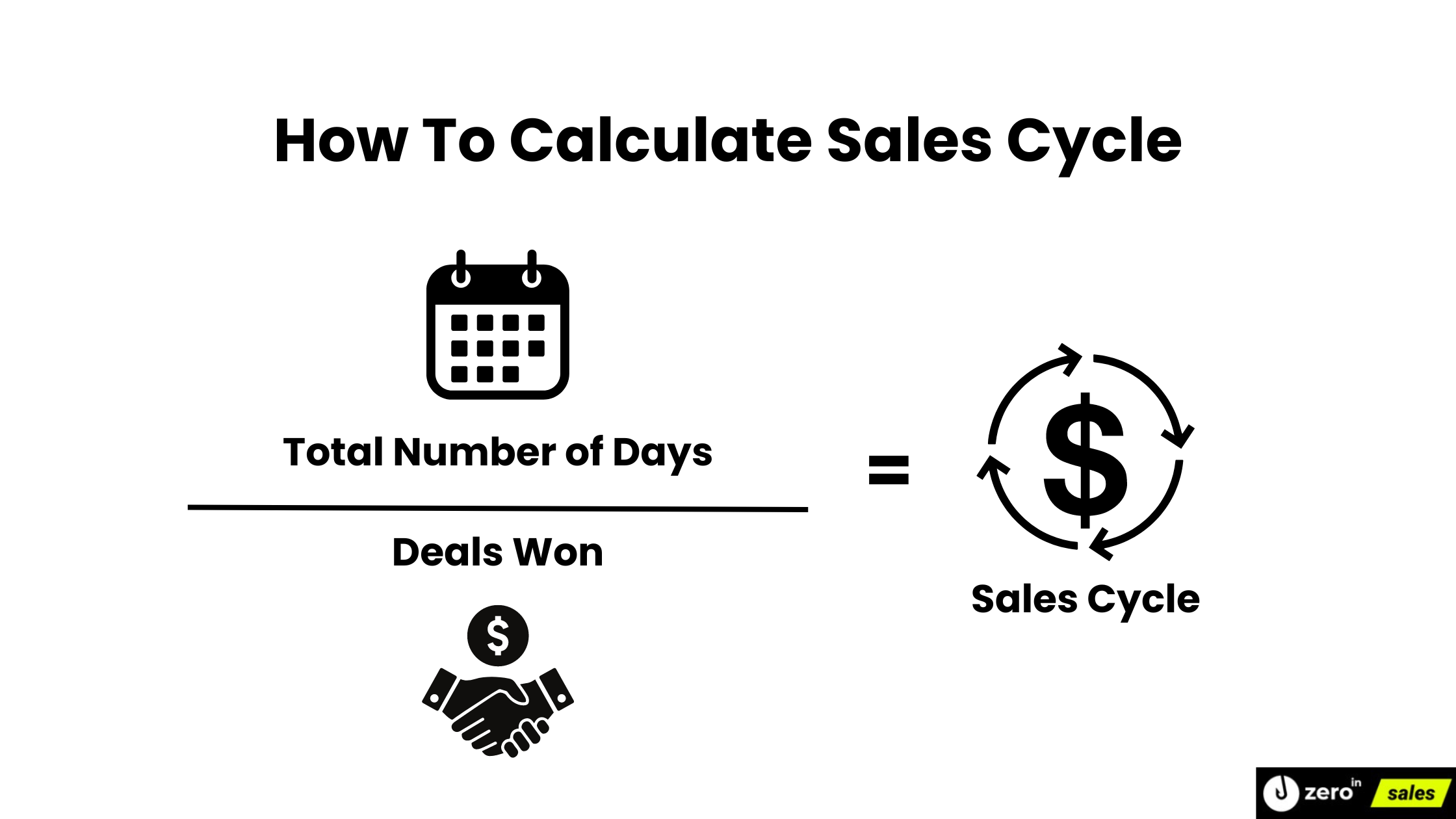
This metric is crucial because it tells you about the pace and efficiency of your sales operations.
A shorter sales cycle is often seen as a sign of efficiency.
It means your team is moving prospects through the pipeline quickly, without unnecessary delays.
This could be due to a number of factors – maybe your sales pitch is exceptionally compelling, or your team is really good at identifying and focusing on high-quality leads.
On the flip side, a longer sales cycle isn’t always a bad thing, especially if you’re in an industry with complex sales, like high-tech or B2B sectors.
Here, longer cycles might be the norm due to the nature of the products or services being sold.
However, if your sales cycle is longer than the industry average, it might indicate some inefficiencies or bottlenecks in your process.
In the end, understanding your Sales Cycle Length isn’t just about counting days. It’s about fine-tuning your sales engine to run as efficiently as possible, matching the pace of your market and the nature of your product.
What are Sales Activity Metrics?
Sales Activity Metrics are your day-to-day playbook stats.
These metrics give you a detailed look at the specific tasks and efforts your team is putting in, rather than focusing solely on the outcomes.
Think of these metrics as the behind-the-scenes work – the calls made, emails sent, meetings booked.
They’re the heartbeat of your sales process, giving you insight into how your team operates on a daily basis.
By tracking these, you get a clear picture of your team’s work ethic, strategies, and time management.
Here are a few examples of sales activity metrics:
1. Number of Calls Made: How many sales calls are your reps making each day?
2. Emails Sent: The volume of sales-related emails sent out.
3. Meetings Scheduled: How many meetings each rep is setting up?
4. Follow-up Contacts: Tracking the follow-up attempts after initial contact.
5. Proposals Sent: The number of proposals or quotes sent to potential customers.
6. Social Media Engagements: Interaction on platforms like LinkedIn for social selling.
7. Demo Presentations: How many product demos are your reps conducting?
8. Networking Events Attended: Participation in trade shows, networking events, etc.
9. CRM Updates: Keeping track of data entry and management in your CRM system.
10. Training Hours: Time spent on skills improvement and sales training.
As you see these metrics are about activity and effort. They measure those two things. They help you understand whether your team is doing enough of the right things to create opportunities and drive sales.
By keeping an eye on these, you can identify areas where your team is excelling and areas where they might need a push or more support.
How to measure Sales Productivity?
Okayyy, so we’ve gone through a bunch of metrics, talked about the whats and whys, but the real question is: how do you make sense of all this?
How do you turn these numbers into insights, and blend everything together to get a clear picture of your sales productivity?
This part is all about the methods – the practical steps to measure and understand your team’s performance.
We’re talking about strategies that help you see the big picture, so you can make informed decisions and keep your sales engine running smoothly.
Let’s get into the nitty-gritty of measuring sales productivity effectively.
Way #1 Implementing CRM and Sales Analytics Tools
When it comes to measuring sales productivity, you can’t go without good CRM and Sales Analytics Tools.
These are must-haves for keeping track of everything that’s happening in your sales process.
Think of them as your command center – where all your data comes together to give you a complete view.
A robust CRM system does more than just store customer and prospect contact information.
It lets you track every customer interaction, from calls and emails to meetings and sales pitches.
This way, you can see the whole journey of each prospect and customer.
It’s about having a clear, organized view of your pipeline and being able to dive into the details whenever you need.
Sales Analytics Tools take it a step further.
They crunch the numbers for you, turning raw data into easy-to-understand graphs and reports.
Want to know your top-performing reps? Check.
Need to see which strategies are bringing in the most revenue? You got it.
These tools analyze trends, spot opportunities, and even predict future sales based on current data.
In short, implementing CRM and Sales Analytics Tools isn’t just about staying organized – it’s about gaining deep insights into your sales operations.
With the right tools in place, you can measure productivity, fine-tune your strategies, and make decisions backed by solid data. They’re essential for any team serious about boosting their sales productivity.
Way #2 Regular Performance Reviews and Feedback
Regular performance reviews and feedback play a huge part in measuring and improving sales productivity.
This isn’t just about having routine check-ins,
It’s about taking a step back and looking at how each team member is doing, not just in terms of numbers, but in their overall approach to sales.
Regular reviews are crucial.
They keep everyone aligned and focused.
This is your chance to dive into each rep’s performance.
Discuss what’s working, what’s not, and brainstorm strategies for improvement.
Feedback, both giving and receiving, is the key here.
It’s a two-way street.
Your team needs to know how they’re doing, but they also have insights that can improve your sales process.
Encourage open communication.
This way, you can catch issues early, adapt strategies quickly, and keep your team motivated.
Implementing consistent performance reviews and providing constructive feedback can transform your sales team’s performance. It keeps everyone on their toes, encourages continuous improvement, and fosters a culture of open communication.
Way #3 Utilizing Time Tracking Software
Utilizing Time Tracking Software is like having a magnifying glass over your team’s day-to-day operations.
This isn’t about micromanaging, but about understanding where time is being spent – and whether it’s being used in the best possible way.
Time tracking tools shed light on how much time your reps spend on various tasks.
Are they bogged down with admin work when they should be selling?
Are there unexpected time-drains that you hadn’t noticed before?
This software makes it all clear.
It’s not just about tracking hours; it’s about optimizing them.
For instance, if you notice a rep spending a lot of time on prospect research, maybe it’s time to introduce better tools or delegate that task. Or, if another rep spends too little time on follow-ups, that’s an area for coaching.
What’s great about time tracking software is its ability to highlight efficiencies and inefficiencies in your sales process.
You get to see patterns and trends that are not immediately apparent.
Armed with this info, you can make informed decisions about resource allocation, training needs, and process improvements.
Way #4 Sales Pipeline Analysis
Diving into Sales Pipeline Analysis is like opening up the engine of your car to see how it’s really running.
This analysis gives you a clear picture of each stage in your sales process, from the first contact with a lead to the final handshake on a deal.
When you analyze your sales pipeline, you’re looking for bottlenecks, leaks, and opportunities.
Where are deals getting stuck?
Which stage has the highest drop-off rate?
This kind of scrutiny helps you pinpoint exactly where you need to make improvements.
For example, if you’re losing a lot of leads at the initial contact stage, your team might need better training on how to engage prospects.
Or, if deals are consistently falling through at the negotiation phase, it might be time to revamp your pricing strategy.
Sales Pipeline Analysis isn’t just about spotting problems, though.
It also highlights what you’re doing right.
Maybe there’s a stage where your conversion rates are through the roof.
Understanding why can help you replicate that success across the board.
Way #5 Benchmarking Against Industry Standards
Benchmarking Against Industry Standards is like measuring your race time against the best runners.
It helps you see where you stand in the competitive landscape.
This practice involves comparing your sales metrics with industry averages and top performers in your field.
By doing this, you get a reality check:
Are you leading the pack, keeping pace, or falling behind?
Maybe your conversion rates are above average, which is a sign you’re doing something right.
Or perhaps your deal sizes are smaller than the industry norm, signaling an area for growth.
The beauty of benchmarking is that it’s not just about seeing where you lag. It’s also about learning from others.
What are the top performers doing differently?
Can you adopt some of their strategies or tactics?
This is where benchmarking transforms from a report card into a learning tool.
And remember, benchmarking isn’t about copying competitors.
It’s about understanding the best practices in your industry and adapting them to fit your unique business context. It’s a proactive approach to stay competitive and continuously improve your sales productivity.
How can ZeroIn Help you reach your Sales Targets?
Think about this:
How much time does your sales team spend searching for verified business emails during outreach?
You might have a process in place, but ask yourself, is it as efficient as it could be? Are your efforts translating into real sales productivity?
Here we want you to meet ZeroIn.
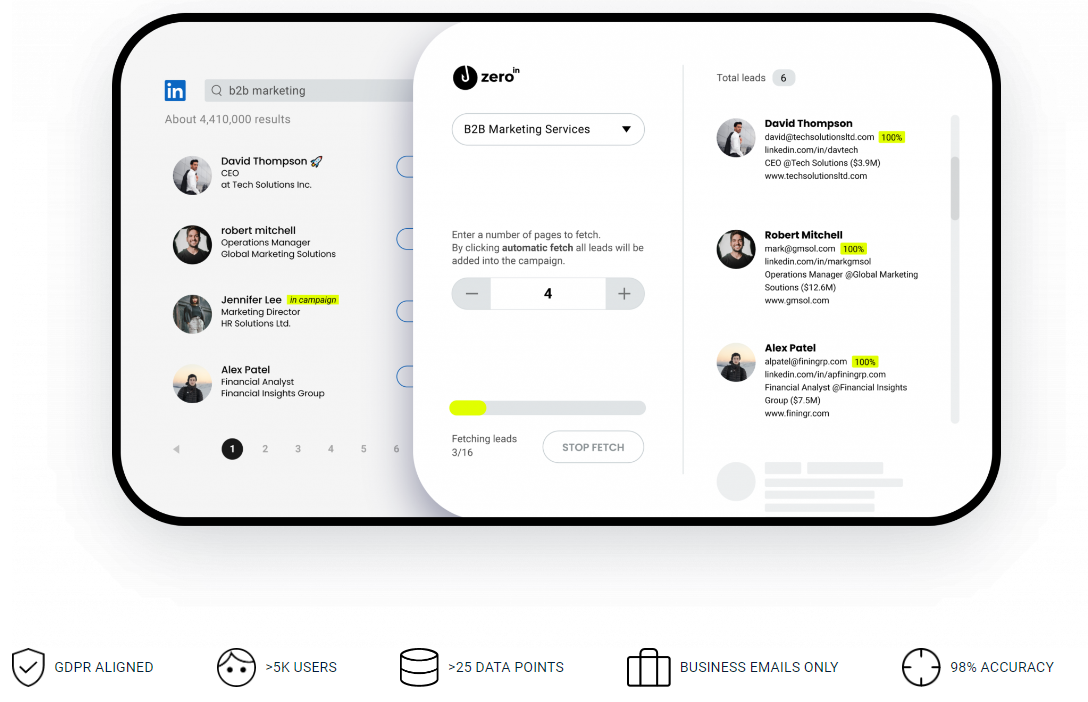
ZeroIn isn’t just another tool in the toolbox. No. It’s the ace up your sleeve for sales productivity.
Basically. it streamlines the tedious task of finding and verifying business emails, making your outreach process a breeze.
Here’s how ZeroIn gives you an edge:
1. Streamlined Email Search: Instead of sifting through databases or guessing email formats, ZeroIn does the heavy lifting. It finds and verifies business emails quickly, letting your team focus on what they do best – selling.
2. Accurate and Reliable Data: The accuracy of ZeroIn ensures that your team isn’t wasting time on dead-end leads or incorrect emails. This boosts efficiency and reduces the frustration of failed contact attempts.
3. Compliance and Peace of Mind: With data privacy laws tightening, ZeroIn’s compliance with regulations like GDPR means you can use it with confidence. You’re not just efficient; you’re also ethical.
4. Enriched Data for Personalized Outreach: ZeroIn doesn’t stop at emails. It provides enriched data points that allow for more personalized and effective sales approaches. This means your team can create connections that resonate with prospects.
5. Vast Database, More Opportunities: With access to a broad database, your team has more chances to connect with the right people. This extensive reach can be a game-changer in hitting those ambitious sales targets.
In short, ZeroIn equips your sales team with the tools they need to boost their productivity.
It bridges the gap between finding a lead and being able to engage them effectively.
In the fast-paced world of sales, having a tool like ZeroIn can mean the difference between meeting your targets and exceeding them.
Give it a try and see why it’s a favorite among sales professionals looking to streamline their processes and maximize their results.
Conclusion
And there you have it.
We’ve traveled through the trenches of sales productivity, uncovering the metrics and methods that truly matter.
This article wasn’t meant to be a pat on the back or just another guide filled with jargon.
It’s a wake-up call.
A call to look beyond the surface and dive deep into the mechanics of your sales team’s performance.
Remember, the real power lies in understanding the nuances, the daily efforts, and the strategies that turn a group of individuals into a high-performing sales machine.
So, as you step back into the grind, keep these insights in hand.
Use them to sharpen your strategies, to fine-tune your team’s efforts, and to build a foundation that’s not just about occasional wins but consistent, sustainable success.
Sales productivity isn’t a one-time checkpoint – it’s an ongoing journey of improvement, and now you’re better equipped to navigate it.
Keep these lessons close, and watch as they transform the way you measure and achieve sales productivity. After all, in the dynamic world of sales, staying ahead means staying informed, and now, you’re just that.
FAQs
What is Sales Productivity?
Sales Productivity is how effectively your sales team converts time and effort into sales results.
Why is it so important to track Sales Productivity?
Tracking sales productivity is crucial because it directly impacts your business’s growth and efficiency.
It’s the key to understanding whether your team is just meeting targets or truly excelling.
By keeping tabs on productivity, you spot and fix issues early, ensuring resources are used wisely, and keeping your team motivated.
Essentially, it’s the compass that guides your sales team towards sustained success and improvement.
What are Sales Productivity Metrics?
Sales productivity metrics are the key figures that show how effectively your sales team operates.
They go beyond just total sales or deal numbers, diving into the efficiency of the sales process itself.
These metrics help you understand both the outcomes (like revenue) and the processes (like time to close a deal), giving you a complete picture of your team’s performance and areas for improvement.
They are essential for evaluating and enhancing both the efficiency and effectiveness of your sales operations.
What key metrics you should consider for Sales Productivity and why?
To gauge sales productivity effectively, consider these key metrics:
1. Revenue: Indicates the total earnings from sales, showing overall success.
2. Sales Conversion Rate: Measures how effectively leads are converted into sales.
3. Average Deal Size: Shows the average revenue per deal, reflecting deal quality.
4. Selling Time: Highlights the time spent actively selling, key for efficiency.
5. Lead Response Time: Tracks how quickly leads are followed up, impacting conversion likelihood.
6. Handling Time: Assesses the duration of sales interactions, indicating process efficiency.
7. Time-to-Productivity: Measures how quickly new reps become effective, reflecting training effectiveness.
8. Opportunity Losses: Identifies missed sales opportunities, highlighting areas for improvement.
9. Quota Attainment: Shows how well sales targets are being met, indicating individual and team performance.
10. Sales Cycle Length: Reveals the time taken to close deals, impacting overall sales efficiency.
These metrics provide a comprehensive view of both the results and processes of your sales activities, helping to identify strengths and areas needing enhancement.
What are Sales Activity Metrics?
Sales Activity Metrics are the daily performance indicators of your sales team. They include:
Number of Calls Made: Tracking daily sales calls.
Emails Sent: Counting sales-related emails.
Meetings Scheduled: Monitoring meetings set up by reps.
Follow-up Contacts: Follow-up attempts post-initial contact.
Proposals Sent: Number of proposals or quotes sent.
Social Media Engagements: Engagements for social selling.
Demo Presentations: Frequency of product demos conducted.
Networking Events Attended: Participation in relevant events.
CRM Updates: Data entry and management in CRM systems.
Training Hours: Time invested in sales training.
These metrics focus on the efforts and activities that contribute to sales success, helping you identify both high-performing areas and those needing improvement.
How do you measure Sales Productivity?
To effectively measure sales productivity, consider these key approaches:
1. Implementing CRM and Sales Analytics Tools: Use these tools for a comprehensive view of sales activities and customer interactions.
2. Regular Performance Reviews and Feedback: Conduct consistent reviews to assess and improve individual and team sales performances.
3. Utilizing Time Tracking Software: Monitor how sales reps allocate their time to optimize productivity and efficiency.
4. Sales Pipeline Analysis: Evaluate each stage of the sales process to identify and address bottlenecks or inefficiencies.
5. Benchmarking Against Industry Standards: Compare your sales metrics with industry norms to gauge competitiveness and identify improvement areas.
How can ZeroIn Help You Reach Your Sales Targets?
ZeroIn streamlines sales productivity by efficiently finding and verifying business emails, saving time and enhancing outreach quality. Its key advantages include:
Streamlined Email Search: Quickly locates and verifies business emails.
Accurate and Reliable Data: Ensures high data accuracy for effective outreach.
Compliance Assurance: Adheres to GDPR, ensuring ethical data use.
Enriched Data for Personalization: Offers detailed data for tailored sales approaches.
Vast Database Access: Provides a wide range of contacts for more outreach opportunities.
ZeroIn equips sales teams with the essential tools to increase productivity and effectively engage leads, helping to meet and exceed sales targets.
